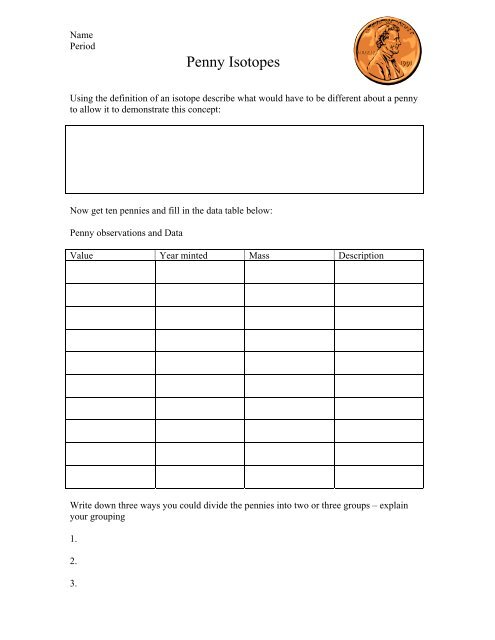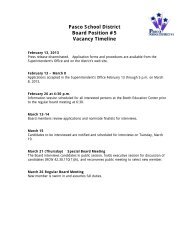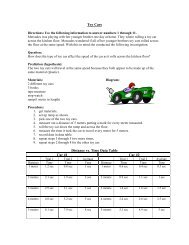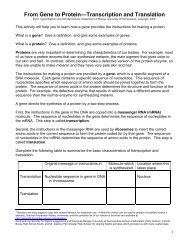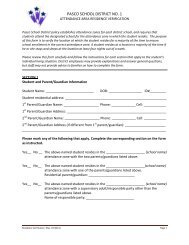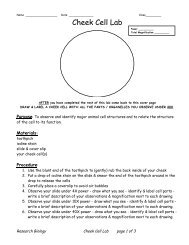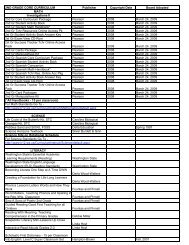Create successful ePaper yourself
Turn your PDF publications into a flip-book with our unique Google optimized e-Paper software.
Name<br />
Period<br />
<strong>Penny</strong> <strong>Isotopes</strong><br />
Using the definition of an isotope describe what would have to be different about a penny<br />
to allow it to demonstrate this concept:<br />
Now get ten pennies and fill in the data table below:<br />
<strong>Penny</strong> observations and Data<br />
Value Year minted Mass Description<br />
Write down three ways you could divide the pennies into two or three groups – explain<br />
your grouping<br />
1.<br />
2.<br />
3.
Name<br />
Period<br />
How did other tables group their pennies differently?<br />
What grouping best fits the definition of an isotope?<br />
Now using that information, find 5 pennies from each group and calculate the average<br />
mass for each<br />
Data Table for Average Mass of Pennies<br />
<strong>Penny</strong> trial number Mass of old penny Mass of new penny<br />
Average mass of penny<br />
Now calculate the predicted mass of 3 old pennies and 7 new pennies. (show your work)<br />
What would be the average mass of the new group of pennies?<br />
Now find out what value a random sample of pennies most closely matches.<br />
Random mass sample of 25 pennies<br />
Trail<br />
number<br />
Total mass of<br />
25 pennies<br />
Average mass<br />
of 25 pennies<br />
Average that best matches<br />
(Old 1 cent) (New 1 cent) (Random average)
Name<br />
Period<br />
What a scientists says to explain this.<br />
<strong>Isotopes</strong> are atoms of the same element that have the same properties but have different<br />
masses based on the number of neutrons present. The number of neutrons is generally<br />
equal to or more than the number of protons – with the main exception of Hydrogen, which<br />
usually has one proton and no neutrons.<br />
In Atoms each proton and each neutron has a mass unit of one<br />
A Pure sample of copper (Cu) would consist of<br />
69 % Cu-63<br />
31 % Cu –65<br />
or in 100 atoms there would be ___________Cu- 63 and _____________Cu-65<br />
Since copper has an atomic number of 29, that means it has _________ protons in its<br />
nucleus. Cu – 63 has a mass number of 63, with 29 of that mass due to proton mass. Then<br />
the number of neutrons would have to be _________ to equal the total mass of the isotope<br />
29 + ______ = 63 (mass units)<br />
Copper 65 would still have only _________ protons, because the number of protons in an<br />
element does not change! Instead it would have more neutrons<br />
29 + ______________ = 65; making it heavier by 2 mass units.<br />
To find the Atomic mass of Copper we would need to do some math<br />
(% of isotope Cu-63 in decimal form) times (mass of isotope Cu -63) PLUS<br />
(% of isotope Cu-65 in decimal form) times (mass of isotope Cu -65)<br />
Now Calculate the atomic mass of copper using this information and compare your answer<br />
to the atomic mass of copper in the textbook (periodic table)<br />
Write this formula using the number values and put them on a Sheet of paper to share with<br />
the rest of the class.<br />
Questions:<br />
1. How close does your calculated value for copper match the atomic mass in the<br />
periodic table?<br />
2. What happens to an atom of any element as you add neutrons to its nucleus?<br />
3. Oxygen has an atomic number of 8 and an atomic mass of 15.99.<br />
a. What can you say about most of the oxygen isotopes?
Name<br />
Period<br />
b. About some of the oxygen isotopes?<br />
What Happens to the stability of atoms when the mass increases?<br />
Write a prediction of what will happen when you create one stack of pennies – face down<br />
with 3 pennies (protons) and face up with 3 pennies (neutrons). Then added pennies to<br />
increase the number of protons and neutrons in the stack until you had an atom with 20<br />
protons and 25 neutrons?<br />
MY PREDICTION<br />
Now using the cards given to you write down the information and the results below:<br />
Isotope<br />
A<br />
Isotope<br />
B<br />
Isotope<br />
C<br />
Atomic<br />
Number<br />
Mass<br />
number<br />
Number of neutrons<br />
Results / stability of the stack<br />
What element did you model?<br />
Class Data<br />
Write a conclusion for this question based on the class data (question, answer, data, why<br />
you think this happen)


